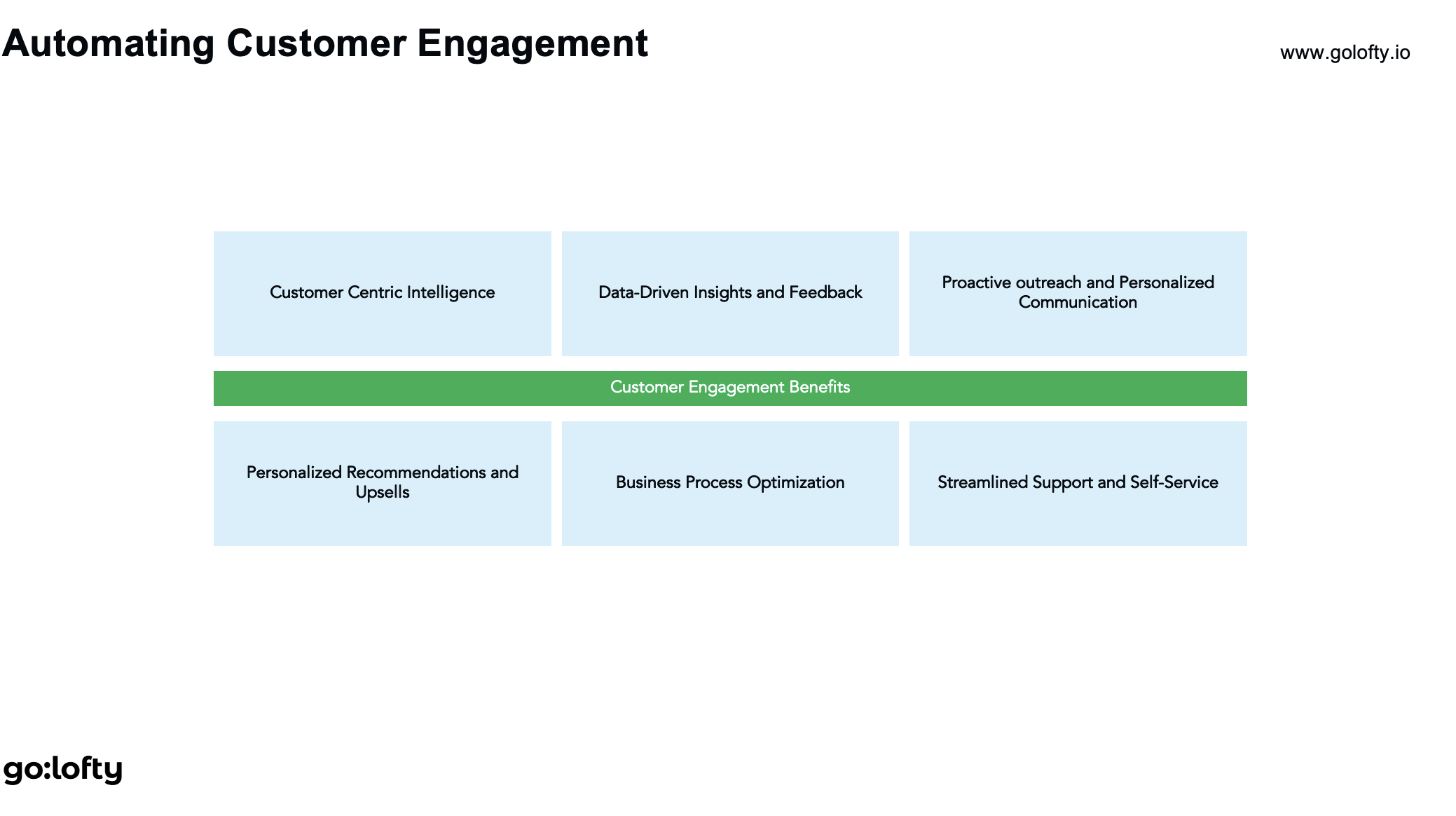
In today’s digital-first landscape, effective customer engagement is more than a nice-to-have—it’s essential for building loyalty and driving growth. However, many companies are eager to dive into automation without first laying the essential groundwork. Before thinking and investing in automation, it’s crucial to review the existing level of digitalization and ensure alignment with the broader digital transformation strategy and timelines. Companies need to make sure that they’re not just adding technology for technology’s sake but are truly enhancing the customer journey.
Once these foundational elements are in place, the next step is to design a best-in-class customer experience that is evidence-based and customer-centric. This should be supported by a robust customer engagement strategy, with well-defined processes for execution. Only after these pillars are in place should organizations review potential use cases for AI, machine learning, and generative AI applications to automate steps that experience the most friction. By following this approach, businesses can implement automation that drives real value.
Why Customer Engagement Automation Needs a Strategic Foundation
Automation is a powerful tool, but without a solid foundation, it can lead to fragmented experiences and missed opportunities. To avoid this, organizations should first ensure that their digital transformation efforts are on track. This includes having a clear digital roadmap that outlines how automation fits within the larger goals of the business. With a clear foundation, companies can then build an exceptional customer experience designed specifically to meet the needs of their audience.
After the foundation is set, it’s time to outline a customer engagement strategy. This involves identifying key customer touchpoints and crafting tailored processes to foster engagement. With a clear strategy and processes in place, businesses can then examine which areas of the customer journey would benefit most from automation, especially where high levels of friction occur.
Practical Use Cases for Customer Engagement Automation in Marketing
1. Automated Lead Nurturing Campaigns
Once the foundational elements are aligned, automated lead nurturing becomes an impactful area to consider for automation. Lead nurturing is about guiding potential customers through the sales funnel with content that resonates with their needs, delivered at the right time. By automating these interactions, marketing teams can nurture prospects consistently without manual follow-up.
- How it works: When a prospect engages with initial content, automation can trigger a personalized sequence of follow-up messages based on their behavior. For example, if a customer downloads a whitepaper, the system can automatically send a related case study a few days later.
- Benefits: Automated lead nurturing ensures that prospects receive relevant content consistently, helping to build trust and improve conversion rates while freeing up marketing teams for other tasks.
2. Customer Onboarding Workflows
A seamless customer onboarding experience sets the stage for a successful relationship. After investing time in designing an optimal onboarding process, automating key steps ensures that every new customer receives consistent support and information.
- How it works: Once a new customer makes a purchase, they enter an automated onboarding sequence that may include a welcome email, product tutorials, and follow-up messages with helpful resources. AI and machine learning can even adapt content based on customer behavior, providing additional guidance where engagement is low.
- Benefits: Automated onboarding reduces the risk of customers feeling unsupported, increases satisfaction, and leads to higher long-term retention.
3. Personalized Content and Product Recommendations
Once data shows that customers engage positively with personalized content, AI can enhance this process by making real-time recommendations based on behavior and preferences. Personalized recommendations are key to deepening engagement and showing customers that the brand understands their needs.
- How it works: By analyzing past interactions, AI-powered recommendation engines can suggest relevant products or content, whether in emails, on the website, or in-app. For example, an e-commerce platform could suggest accessories based on a recent purchase.
- Benefits: Personalized recommendations not only improve the customer experience but also boost conversions and average purchase sizes by showcasing items the customer is likely to find valuable.
4. Triggered Engagement Based on Customer Behavior
Automation can help marketing teams react quickly to customer behaviors, like abandoned carts or periods of inactivity. When a customer shows specific engagement patterns, automation can trigger personalized follow-ups, keeping the customer engaged with minimal manual intervention.
- How it works: Common triggers include reminders for abandoned carts, re-engagement campaigns for inactive accounts, and feedback requests after purchases. AI can further enhance these triggers by determining the best time to send messages based on previous engagement patterns.
- Benefits: Triggered engagement helps retain customer interest, recover lost opportunities, and maintain brand presence even after lapses in activity.
5. Customer Feedback Collection and Analysis
Feedback is crucial for refining the customer experience. Once an optimal feedback collection process is designed, automation can streamline this process, making it easier to gather insights without manual effort and even using AI to interpret and act on feedback.
- How it works: Following key customer interactions, automated surveys can be sent via email or SMS. AI-powered sentiment analysis can analyze open-ended responses, helping businesses understand underlying sentiments and emerging trends.
- Benefits: Automated feedback collection provides a continuous stream of insights, allowing marketing teams to adapt strategies quickly and improve the customer experience.
6. Loyalty and Rewards Program Management
Loyalty programs drive engagement, but managing them manually can be cumbersome. By automating certain loyalty workflows, companies can ensure customers are reminded of their rewards and stay engaged with the brand.
- How it works: Once a customer joins a loyalty program, they receive automated reminders about their points balance, upcoming rewards, or points expiration. AI can also suggest loyalty-related offers based on purchase history, such as double points on items they frequently buy.
- Benefits: Automated loyalty management keeps customers engaged with the brand, boosting retention and maximizing the effectiveness of the loyalty program.
7. Multi-Channel Campaign Coordination
With a clear customer engagement strategy in place, multi-channel campaigns ensure consistent messaging across various platforms. Automating these campaigns helps marketing teams maintain a cohesive experience for customers regardless of their preferred channel.
- How it works: Automation coordinates content across email, social media, SMS, and other channels. Customers who engage with an email might then receive tailored content on social media or through SMS.
- Benefits: Multi-channel automation provides a seamless experience across platforms, ensuring brand consistency and increasing engagement by meeting customers where they are.
Assessing AI and Automation Opportunities
Once foundational processes are automated, companies can look for additional opportunities to introduce AI and machine learning. AI can take automation to the next level by handling more complex tasks, such as predictive customer segmentation or even sentiment analysis. For instance, AI can predict which customers are most likely to churn, enabling targeted retention efforts.
Reviewing potential use cases for AI means identifying points of friction in the customer journey and areas where predictive insights could enhance engagement. By focusing on these high-impact areas, companies can ensure they’re investing in AI where it will yield the greatest benefit.
Key Considerations for Implementing Automation in Customer Engagement
Successful automation in customer engagement requires thoughtful planning:
- Digital Readiness: Ensure the company’s level of digitalization aligns with automation goals and digital transformation timelines.
- Customer-Centric Design: Every automated process should enhance the customer experience, not just improve efficiency. Focus on evidence-based, customer-centric design.
- Strategic Alignment: Automation must align with the overall customer engagement strategy. Each automated process should directly support engagement objectives.
- Use Cases with High Friction: Start with automation in areas where manual intervention creates bottlenecks or reduces responsiveness. Let data guide you to the processes that will benefit most.
Final Thoughts
Automation can significantly enhance customer engagement, but only when implemented as part of a holistic strategy. By first ensuring that digital and strategic alignment are in place, businesses can create a more cohesive, high-quality customer experience. From automated lead nurturing and onboarding to multi-channel engagement, these automations allow marketing teams to focus on strategy while still delivering timely, relevant interactions.
At Go:lofty Consulting, we help organizations develop customer engagement strategies that leverage the power of automation and AI thoughtfully. From foundational strategy and customer-centric design to automation planning, our team provides the expertise to guide your transformation. Visit golofty.io to learn how we can help you elevate customer engagement through targeted, high-impact automation.




